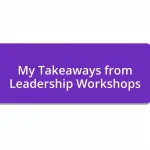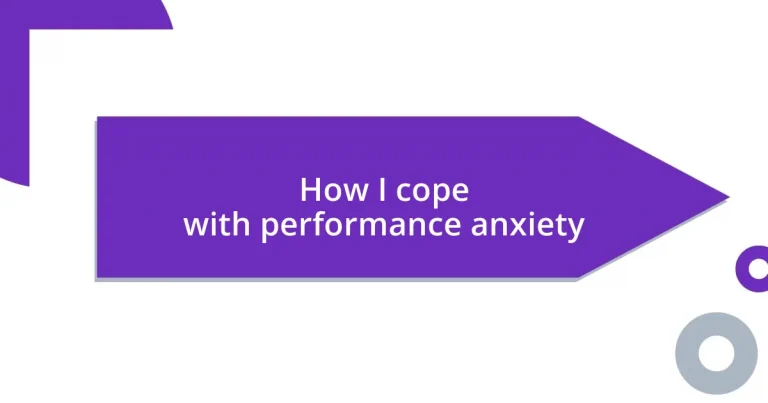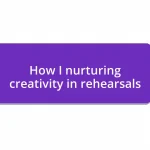Key takeaways:
- Performance anxiety is driven by fear of failure and pressure to meet expectations, affecting even well-prepared individuals.
- Effective coping strategies include deep breathing, visualization, and adopting a growth mindset to transform anxiety into a learning opportunity.
- Seeking professional help, such as therapy, can provide tailored strategies like exposure therapy and cognitive-behavioral techniques.
- Building long-term resilience involves mindfulness practices, embracing failures as learning experiences, and cultivating a supportive network.
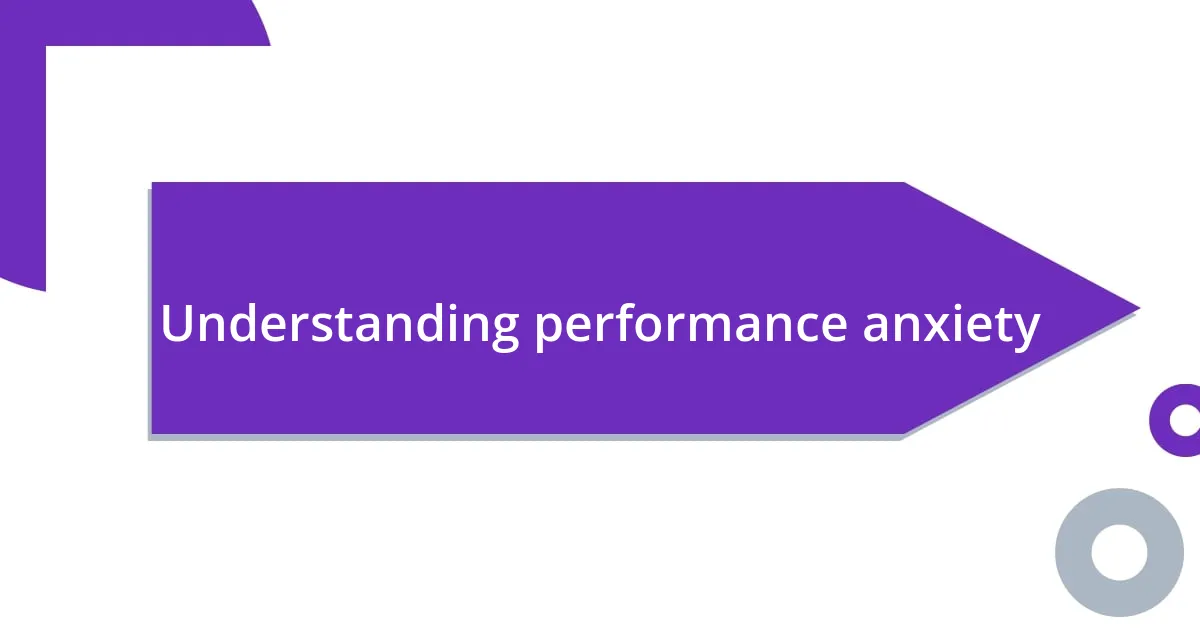
Understanding performance anxiety
Performance anxiety is a complex emotional experience that can hit anyone, no matter how skilled or prepared they feel. I remember standing backstage before my first major presentation, heart racing, palms sweaty, consumed by the fear of judgment. It made me wonder: why do I let this fear take over when I know I’ve prepared thoroughly?
This anxiety stems from a deep-rooted fear of failure and the pressure to meet expectations, whether they’re self-imposed or coming from others. I often found myself caught in a cycle of overthinking, worrying about every small detail. Have you ever felt that nagging voice inside your head saying you’re not good enough? That was my constant companion, and it made even the simplest tasks feel monumental.
Understanding the physiological responses—like increased heart rate and shallow breathing—helped me realize that I wasn’t alone. I began to see these reactions as normal, almost like the body’s way of gearing up for something important. I often asked myself, how can I turn this natural response into something constructive? It was this shift in perspective that truly started to change how I cope with performance anxiety.
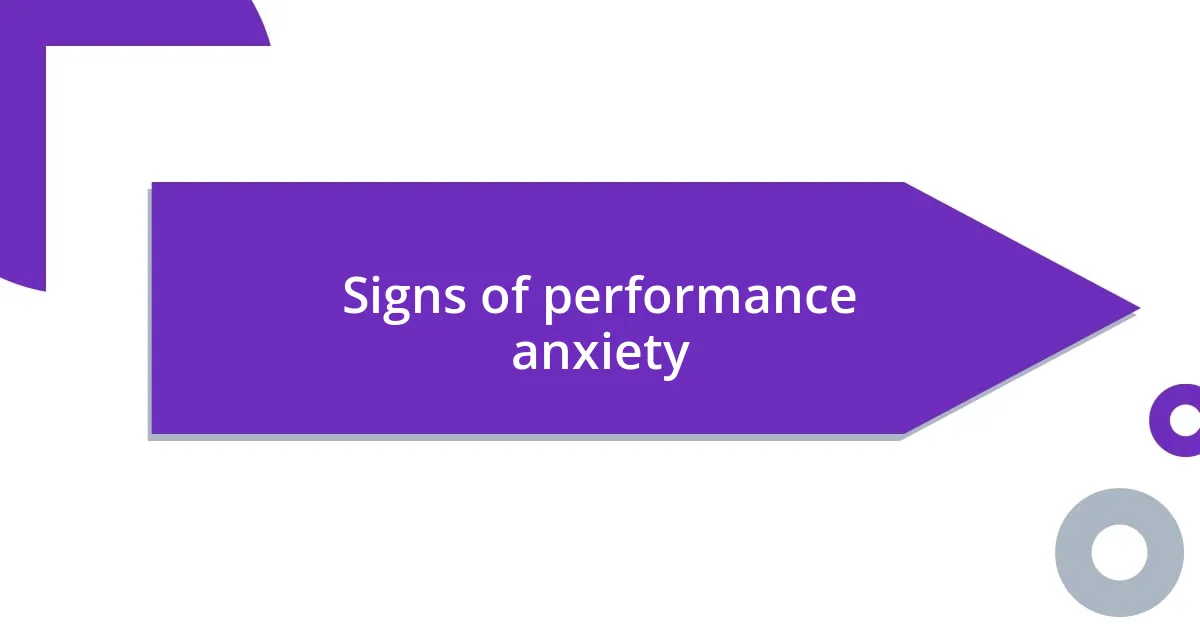
Signs of performance anxiety
Signs of performance anxiety can manifest in various ways, and many of them are subtle yet impactful. For instance, I often notice how my breathing changes when I’m about to perform—short and rapid breaths, as if I’m in a race. It’s a clear signal my body sends me, reminding me that the pressure is on. Recognizing these signs is the first step toward understanding my anxiety.
Here are some common signs of performance anxiety to watch for:
- Increased heart rate
- Sweaty palms
- Trembling hands or voice
- Dry mouth
- Difficulty concentrating
- Feeling of impending doom
- Nausea or stomach discomfort
Sometimes, even before a casual conversation in a group, I can feel that knot in my stomach, indicating that performance anxiety isn’t limited to grand events. By acknowledging these signs, I’ve learned to channel the energy into something productive rather than letting it spiral into self-doubt.
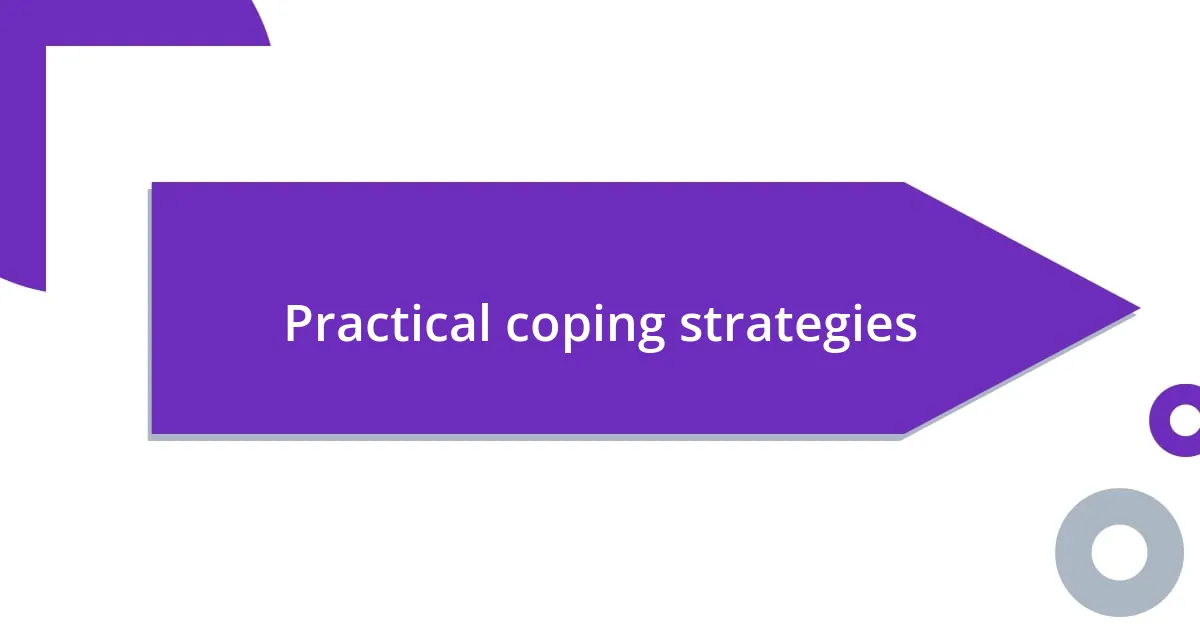
Practical coping strategies
Practical coping strategies for performance anxiety are crucial to managing those overwhelming feelings. One technique that has truly aided me is deep breathing. When I feel the anxiety creeping in, I take a moment to inhale deeply through my nose, hold for a few seconds, and then exhale slowly through my mouth. This simple practice not only calms my nerves but also centers my thoughts, making it easier to face the situation ahead. Have you tried this? It’s amazing how something so basic can be so transformative.
Another strategy I’ve found effective is visualization. Before any performance, I close my eyes and imagine myself succeeding—engaging with the audience, delivering my message clearly, and feeling confident. I remember a time before a big speech when I practiced this technique, imagining each applauding face in the crowd. It filled me with such positive energy that when I took the stage, I felt like I had already won. This practice allows me to focus on positive outcomes instead of potential pitfalls.
Lastly, embracing a growth mindset changed my approach entirely. Instead of fearing failure, I now see it as an opportunity to learn. I used to dread moments when things didn’t go perfectly, but now I reflect on them as part of my journey. This shift in perspective, from self-judgment to self-improvement, has provided me with a freeing sense of resilience in the face of performance anxiety.
| Strategy | Description |
|---|---|
| Deep Breathing | Inhale deeply, hold, and exhale slowly to calm nerves. |
| Visualization | Mentally imagine success to foster confidence before performing. |
| Growth Mindset | Embrace failures as learning opportunities rather than setbacks. |
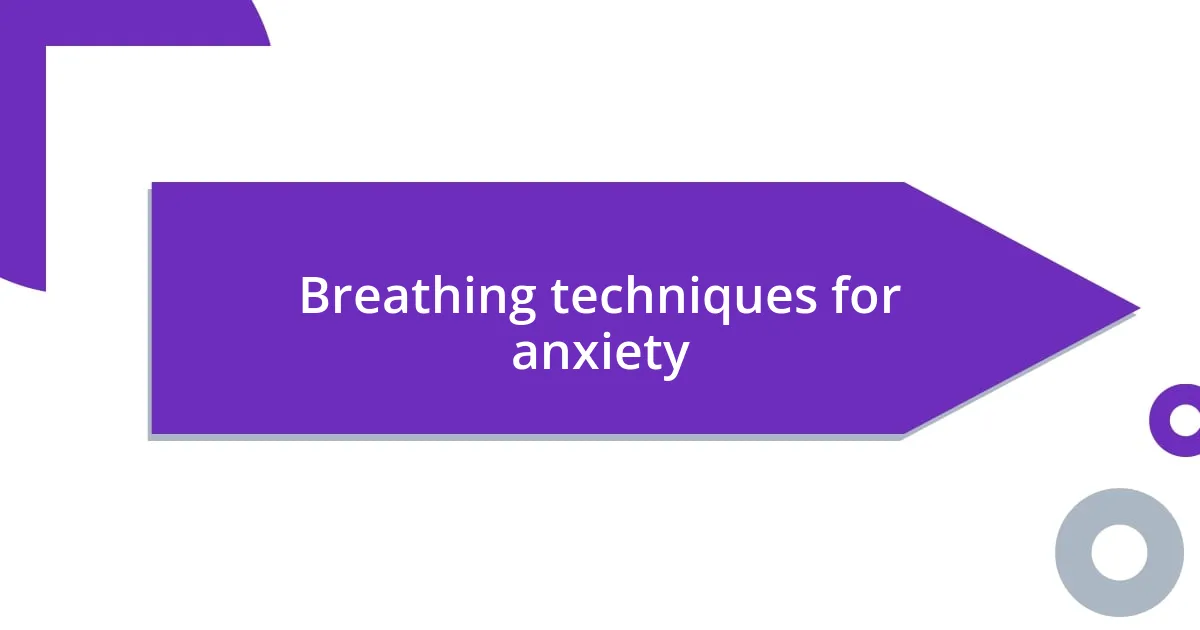
Breathing techniques for anxiety
When anxiety strikes, I often find solace in a simple breathing technique called the 4-7-8 method. I breathe in for a count of four, hold for seven, and then exhale slowly for eight. It feels like I’m releasing not just the oxygen, but the tightness in my chest, too. Have you tried it? There’s just something liberating about elongating my breaths that instantly slows the racing thoughts.
Another technique that resonates with me is box breathing. The rhythmic pattern of inhaling, holding, exhaling, and holding again feels almost meditative. Each side of that imaginary box represents a new breath. I recall a time when I was backstage, feeling the pressure mounting before a performance. Following this method grounded me, allowing me to anchor myself before stepping into the spotlight. It transformed my anxiety into energy I could use.
What often surprises me is how quickly I can shift my mindset through breathing. Sometimes, taking just a moment to focus on each inhalation and exhalation helps me realize that the anxiety isn’t as all-consuming as I feared. As I let go of my breath, I let go of doubt, too. Have you noticed that deeper breathing can create a shift in your perspective? For me, each breath is a reminder that I can face whatever comes my way, one inhale at a time.
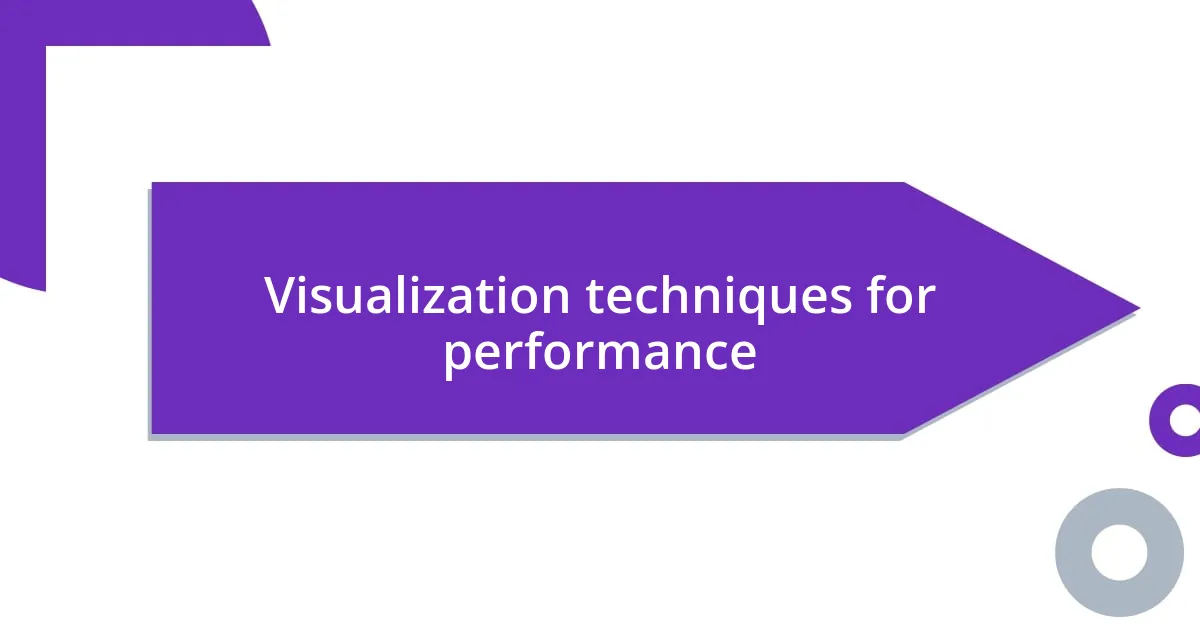
Visualization techniques for performance
One visualization technique that I’ve found particularly powerful involves creating a vivid mental image of my performance environment. I take a moment to picture everything in detail: the stage, the audience, and even the sounds I might hear. This process helps me feel familiar with the space, almost like I’ve already been there, which can ease the jitters. Have you ever imagined your surroundings this way? When I practiced this before a crucial presentation, it was as though I was stepping into a scene I had already rehearsed.
Another approach I love is positive affirmations intertwined with visualization. I’ll visualize myself not just succeeding, but also visualizing specific affirmations in my mind—phrases like “I am prepared,” or “I am confident.” This combination transforms my mental space into a sanctuary of positivity. I remember an event where I repeated these affirmations while picturing myself confidently addressing the audience. By the time I took the stage, I felt invincible, as if I had armed myself with a shield made of my own positive thoughts.
Lastly, I sometimes create a mental movie of my performance, playing it out in my mind from start to finish. As I visualize each moment, I include not just the success but also how I would handle potential obstacles. This proactive approach makes me feel well-equipped for anything that might come my way. For instance, during a recent workshop, I visualized not only the applause but also how I’d respond if a technical glitch occurred. Having rehearsed those reactions in my mind gave me a sense of readiness that ultimately led to a smooth and enjoyable experience. Have you considered crafting your own mental movie before a big event? It can be a game changer!
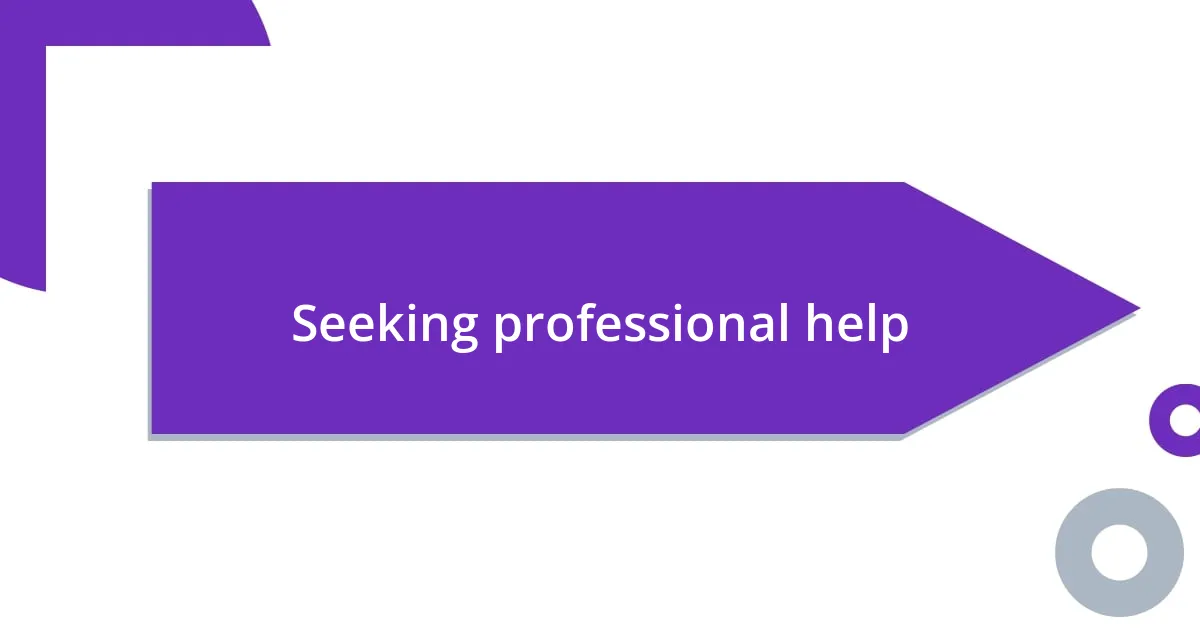
Seeking professional help
Seeking professional help can be a transformative step in managing performance anxiety. I remember the first time I reached out to a therapist—there was a mix of vulnerability and relief. During our sessions, we talked about my experiences in a way that made me feel understood, helping me to untangle the emotions I had long bottled up. Have you ever felt that a simple conversation could shed light on your inner struggles? For me, it certainly did.
In therapy, I learned practical coping strategies tailored to my specific needs. There was one particular strategy that involved exposure therapy, where I gradually faced the situations that caused anxiety. I recall practicing my performance in front of a small group of trusted friends, and each time, the fear lessened a bit more. It’s fascinating how facing our fears in a safe environment can foster such growth. Have you considered how stepping outside your comfort zone, even in small ways, could alter your perspective?
Consulting with a mental health professional also opened up avenues I hadn’t explored before. Cognitive-behavioral therapy (CBT) was an eye-opener for me, allowing me to understand how my thoughts shaped my feelings and behaviors. It was enlightening to recognize those negative thought patterns that crept in before a performance. I often ponder how much power our mindset holds—what if we could shift those thoughts to something empowering? Seeking professional help can truly be the first step toward bettering not just your performances, but your overall well-being.
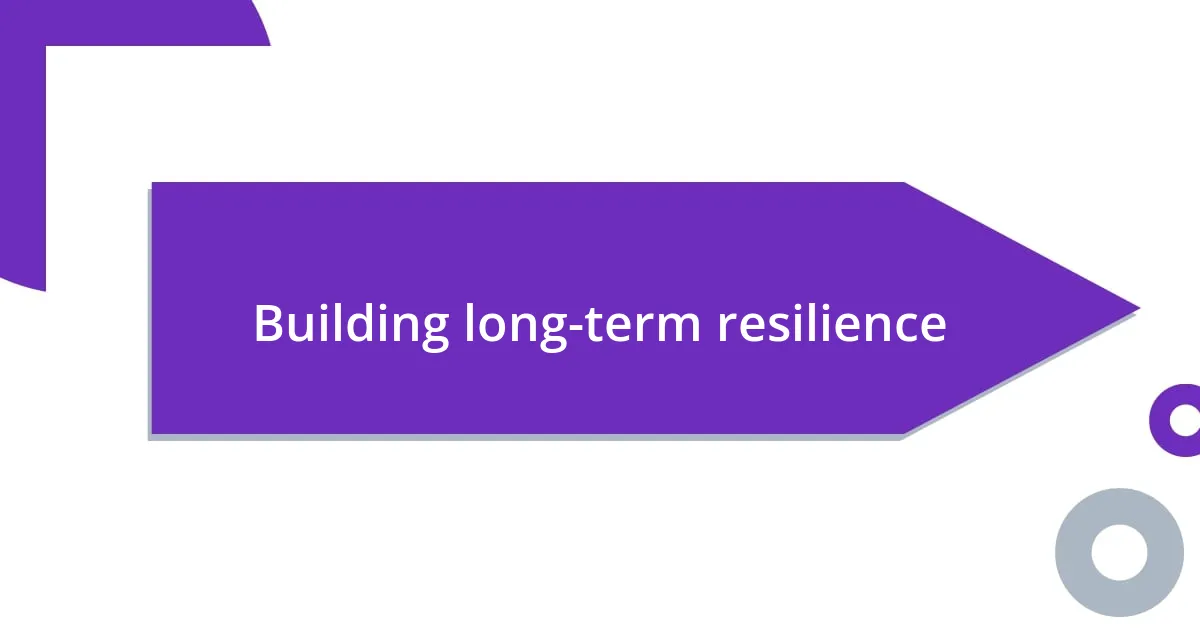
Building long-term resilience
Building long-term resilience is a journey that goes beyond immediate coping strategies. I’ve often found that developing routines centered around mindfulness can be incredibly effective. For example, I dedicated a few minutes each morning to meditation and deep breathing. This practice not only calmed my mind but also fostered a sense of grounding that I carried with me throughout the day. Have you thought about incorporating moments of stillness into your routine? It can make a world of difference.
As I reflect on my experiences, I realize that embracing failures as part of the process has been vital in building my resilience. There was a time when I bombed a presentation in front of a large audience. Initially, I felt crushed, but I used that moment as a learning opportunity. By analyzing what went wrong, I discovered specific areas for improvement rather than letting the setback define me. How often do we view failures as stepping stones instead of stumbling blocks? Shifting this perspective can change the game entirely.
Moreover, maintaining a supportive network has proven invaluable in my journey. Surrounding myself with friends who encourage and uplift me has been a key factor in my resilience-building. After one particularly challenging performance, I shared my feelings with a close friend who had faced similar challenges. His understanding and shared experiences reminded me that I’m not alone on this path. Have you considered who you turn to for support during tough times? Building a community that fosters understanding can be a cornerstone of resilience.







